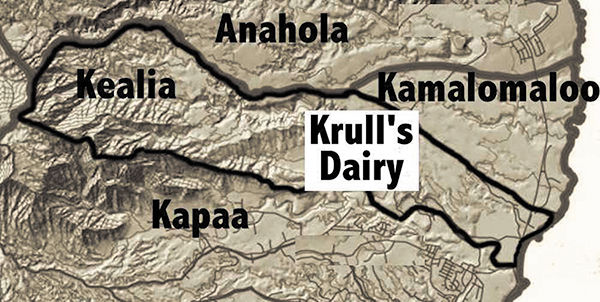In 1854, German immigrant Ernest Krull purchased a tract of land at Kealia, Kauai from the Hawaiian Government for $200 (about $5,720 in 2013 dollars), which extended westward from the area where the Spalding Monument would later be built to
In 1854, German immigrant Ernest Krull purchased a tract of land at Kealia, Kauai from the Hawaiian Government for $200 (about $5,720 in 2013 dollars), which extended westward from the area where the Spalding Monument would later be built to nearly the vicinity of the Waipahee Slippery Slide.
Then, about six years later, Krull began operating a dairy on his land for the purpose of selling visiting whaling ships and Honolulu merchants beef and dairy products — mainly hides, tallow and butter. He sold firewood to ships anchored off Anahola as well.
During the 1860s and early 1870s, large herds of cattle could be seen roaming over Krull’s broad pastures.
While touring Kauai in 1863, American visitor Mary E. Anderson described Krull’s dairy homestead at Kalualihilihi as follows:
“Mr. Krull has a large dairy, which in part supplies the Honolulu market with butter. He has a well-conducted, elegant and tasteful establishment; indeed, it was difficult to imagine that no lady’s hand was employed in it.
The grounds about the house are prettily laid out, and two walks lead to a picturesque summer-house, called “Bellevue,” from which one looks off over an extensive plain to the sea. We slept in a nice grass house with matting on the side instead of paper. Familiar engravings adorned the walls, and the beds, with their pretty muslin mosquito-curtains, looked inviting enough to the weary traveler.
We saw many kinds of tea-roses with their delicate tints. The garden abounded in a variety of vegetables, and we feasted on strawberries which were hanging on their stems in the morning. Within sight was a fine bluff extending down to the sea.”
Krull sold his dairy and ranch lands to sugar planters Capt. James Makee and his son-in-law, Col. Z. S. Spalding, in 1876 for the sum of $30,000 ($673,000.00 in today’s dollars) — lands that would later become part of Makee Sugar Company and eventually, Lihue Plantation.



